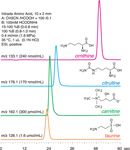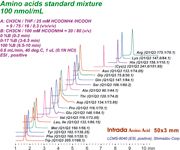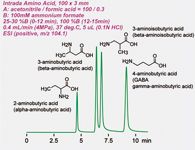Analysis of Amino Acids and Related Compounds Using Intrada-Amino Acid Column and LC–MS/MS or LC–MS Systems
Amino acids, dipeptides, and their related compounds are analyzed in a wide variety of industries.
Amino acids, dipeptides, and their related compounds are analyzed in a wide variety of industries. Universally, the challenge has always been the need for tedious derivatization procedures that can lengthen sample prep and run times by as much as 60%. Another challenge has been that many isobaric amino acids such as isoleucine and leucine can be difficult to separate due to their similar chemistry and molecular weight. To overcome these challenges, Imtakt Corporation has introduced the Intrada-AA column. This column has a novel stationary phase capable of retaining and eluting amino acids without requiring pre or post labeling that is compatible with mass spectrometric detection. This column yields high quality data not only on triple quad mass spectrometers but also on single-quad mass spectrometers.

Figure 1: High throughput analysis of related small molecules is possible using Intrada-AA and detection via single quadrupole mass spectrometry.
Experimental
All data were generated using a semi-micro HPLC system equipped with MS detection in positive ion mode. High throughput separations of carnitine-related compounds (Fig. 1) were accomplished using an Intrada-AA 10 × 2 mm column. Separation of amino acids (Fig. 2) was accomplished using an Intrada-AA 50 × 3 mm column, gradient elution was then used to elute the amino acids off of the column within 10 min. Separation of GABA isomers (Fig. 3) was done using an Intrada-AA 100 × 3 mm column. Mobile phase A used in all experiments included ACN:Formic Acid, and Mobile Phase B consisted of 100 mM ammonium formate. Amino acids were detected using a Shimadzu LCMS-8040 in positive ion mode.

Figure 2: Intrada-AA achieves excellent separation of amino acids in less than 10 min using triple quadrupole MS detection.
Discussion
The Intrada-AA column is able to retain and elute amino acids. No time-consuming labeling methods are required for detection via mass spectrometry, and excellent batch-to-batch column reproducibility means that high throughput and accurate separations are finally possible.

Figure 3: Difficult-to-separate GABA isomers can finally be resolved and detected using Intrada-AA columns on LCâMS systems.

Imtakt USA
1315 Walnut Street, Suite 619, Philadelphia, PA 19107
tel. (888) 456-HPLC, (215) 775-8902, fax (501) 646-3497
Website: www.imtaktusa.com; Email: info@imtaktusa.com

SEC-MALS of Antibody Therapeutics—A Robust Method for In-Depth Sample Characterization
June 1st 2022Monoclonal antibodies (mAbs) are effective therapeutics for cancers, auto-immune diseases, viral infections, and other diseases. Recent developments in antibody therapeutics aim to add more specific binding regions (bi- and multi-specificity) to increase their effectiveness and/or to downsize the molecule to the specific binding regions (for example, scFv or Fab fragment) to achieve better penetration of the tissue. As the molecule gets more complex, the possible high and low molecular weight (H/LMW) impurities become more complex, too. In order to accurately analyze the various species, more advanced detection than ultraviolet (UV) is required to characterize a mAb sample.
SEC-MALS of Antibody Therapeutics—A Robust Method for In-Depth Sample Characterization
June 1st 2022Monoclonal antibodies (mAbs) are effective therapeutics for cancers, auto-immune diseases, viral infections, and other diseases. Recent developments in antibody therapeutics aim to add more specific binding regions (bi- and multi-specificity) to increase their effectiveness and/or to downsize the molecule to the specific binding regions (for example, scFv or Fab fragment) to achieve better penetration of the tissue. As the molecule gets more complex, the possible high and low molecular weight (H/LMW) impurities become more complex, too. In order to accurately analyze the various species, more advanced detection than ultraviolet (UV) is required to characterize a mAb sample.